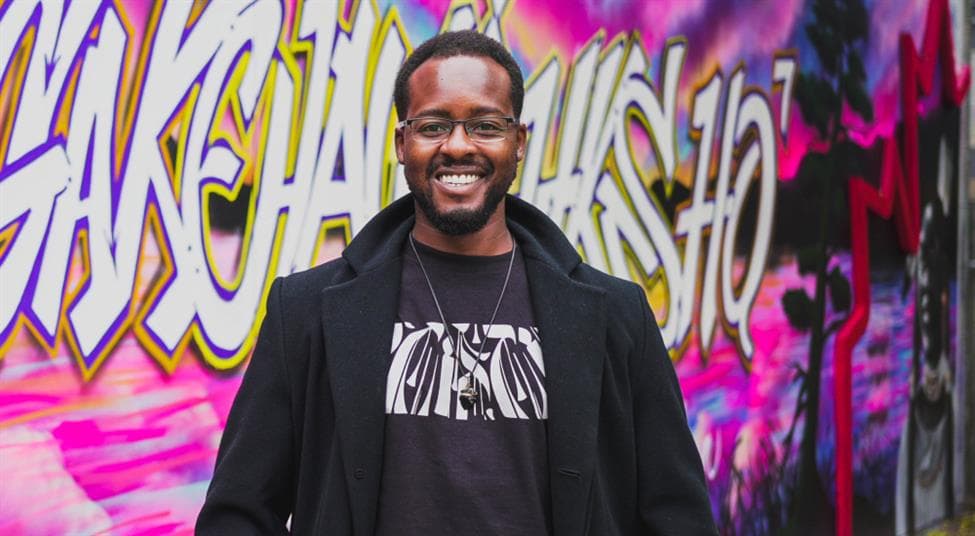In September, for National Day for Truth and Reconciliation, we introduced you to Keegan Starlight who created the first of six murals that Petro-Canada has commissioned across Canada by Indigenous artists. We’re delighted that the second mural in the series, titled ‘Our Children’ has been completed - located at our 117 Jarvis Street in Toronto. The mural was created by Jessey Pacho, aka Phade – a Black artist in Toronto, and his co-artist Indigenous artist (who has chosen to remain anonymous out of respect for their family). Jessey shared with us his and his co-artist’s approach to art and their vision for “Our Children”.
PumpTalk: Why is art an important form of storytelling?
Jessey Pacho: Art helps keep stories alive. Stories that have, in large part, been ignored or kept hidden from Canadian society. I partnered with an Indigenous artist on this project and it's important that we're able to have this mural exist in such a public and prominent place because it shows the world that these peoples, who have practically been erased from this country, are still here and are still a strong and valuable presence. It drives the conversation forward. Art is a very powerful tool in terms of storytelling.
PT: Jessey, what inspires your art?
JP: I started in an art form that is very niche and has many negative connotations associated with it. Now, being able to do my art in public spaces, and being more accepted by society at large in a medium that is still somewhat considered illegal, really inspires me.
Also, we as Black and Indigenous people are using our art to speak on issues that are important to us. So the opportunity to create in public space is what inspires the drive to create. In terms of the art itself, I enjoy playing with color and creating images that people, when they walk by, would just be mind-boggled and wonder “How did the artist create that?!”
PT: What is the story you're portraying in the mural?
JP: On this project I partnered with an indigenous artist who is also a second-generation residential school survivor – they have family that was directly impacted by the residential school system. This mural talks specifically about the moment that we're experiencing as a country in relation to residential schools and the discoveries of Indigenous children that attended these institutions.
In terms of imagery, there's a sunrise above a landmass – nowhere specifically but a representation of one of the many unceded territories in Canada. We chose this imagery so that when people walk by they see something that's bright and colourful, but then realize there's a deeper layer of conversation.
Some of the characters in the mural and the dress they're wearing are based on Haudenosaunee culture. Also, one of the characters is an Afro-Indigenous person; Afro-Indigenous people have existed all over the world for a very long time but they are largely ignored and not part of the conversation. By putting an Afro-Indigenous person on this wall, we pay homage to their existence in this country as well.
The lettering at the centre of our mural reads "Our Children" and is written in Cayuga. There's only 60 fluent speakers of the Cayuga language left in the world and that is a direct correlation to the residential schools existing. It's important to us to feature authentic aspects of Indigenous culture on this wall because it's not something that we're seeing a lot of in the public realm. These are important aspects of the history of this country that need to be brought to the forefront.
PT: What does reconciliation mean to you?
JP: Reconciliation is about taking action to do better for our Indigenous population. Every Canadian who benefits from this land has a responsibility to our Indigenous population. They are the original people of this country that we call home. As a nation it's important to acknowledge the experiences of Indigenous Peoples and ensure that we're doing the most we can to reduce the harm that Indigenous Peoples are experiencing due to our Canadian way of life. To create spaces in which Indigenous folks can feel welcome and safe.
PT: As an organization, Suncor (the proud parent company of Petro-Canada) is on a journey of reconciliation. How can art contribute to healing and reconciliation? And what else can businesses like Petro-Canada do to support healing and reconciliation across Canada?
JP: Art keeps these stories alive and keeps the experiences of the people affected by these atrocities at the forefront of conversation. It also creates opportunities. Petro-Canada is creating an opportunity for a Black artist and an Indigenous artist to share their stories in a prominent public space.
Partnering with Petro-Canada in this way shows others within the industry that there's an appropriate way of working with Indigenous communities. Businesses like Petro-Canada can take further actions that support healing and reconciliation by knowing where their investments go and ensure they aren't being funneled into projects that negatively affect Indigenous folks living on unceded territories.
You can hear more from Jessey in the following video.
A big thank you to Jessey and his Indigenous co-artist for creating this mural and sharing their vision for reconciliation; for more art, you can check out Jessey’s Instagram!
Over the next few months we’ll be introducing our other mural artists and revealing their creations. Stay tuned to our Instagram for sneak peeks of their work.





